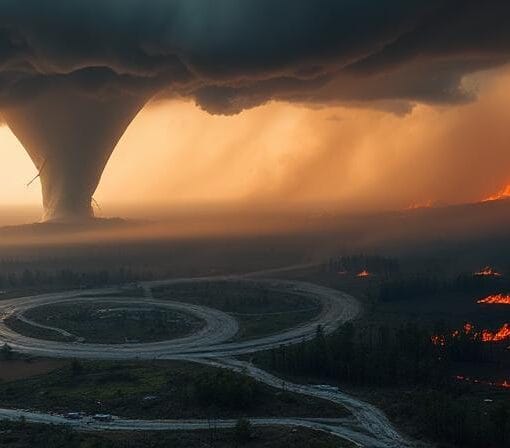Please Note: This post may contain affiliate links. If you click one of them, we may receive a commission at no extra cost to you. As an Amazon Associate, I earn from qualifying purchases.
Top Takeaways and Key Concepts
- Create a simple family emergency plan so everyone knows exactly what to do during crises.
- Practice drills regularly to build automatic response and reduce panic during real emergencies.
- Involve children in planning using fun, memorable activities to help them learn safety steps.
- Include pets in the emergency plan by assigning someone to handle leashes, carriers, and supplies.
- Set one meeting spot and communication plan to avoid confusion and keep everyone connected.
Summary of This Article
This article explains why every family needs a clear, practical emergency plan before disaster strikes. It shows how involving everyone—including young kids and pets—helps reduce panic and builds teamwork during chaotic situations. The article encourages keeping plans simple, practicing drills often, and designating a meeting place and communication strategy. It emphasizes preparation as the key to staying calm, moving quickly, and keeping the entire family safe when emergencies happen.
Short Video Version of this Article
We don’t normally worry about emergencies until they happen. That’s when things start to go wrong. You’re looking for shoes in a hurry. The dog is running around the living room like a tornado. The kids are screaming things like, “Mom, where’s my favorite stuffed bear?” Isn’t it like a real circus?
That’s why it’s really vital to make an emergency plan ahead of time. It might help you relax when things go wrong. But here’s the catch. The plan has to work for all of us. It’s not enough for you or your spouse to know what to do. The kids need to know too. And the dog would too, if only he could hear!
Think about going over the strategy at breakfast. It may become a little messy. Fingers stuck to the table or crumbs all over the place. No need to worry, right? Just get a piece of paper or a napkin. Draw a map of where your family should go. Have fun! Doodles or colors are great. That will help everyone remember it better. Even with stains from jam!
Have a conversation about it. You could even do a small drill. Kids really like to play games! They’ll know what to do when anything unexpected happens this way. When everyone is ready, things will be less hectic.
You may relax a little when you have a plan. You might still be a little nervous, but at least you have a team ready to deal with anything that comes up. Your family’s secret weapon against chaos could be that dirty paper with the jam on it. And who knows? You might even laugh in the thick of it all.
Don’t Forget The Kids (Yes, Even If They’re Tiny)
Kids are like little chaos machines, aren’t they? They soak up info like sponges but can forget the simplest things. What day is it? Who knows! In an emergency, that can be a little scary. Keeping things simple helps a ton.
We started small with fire drills at home. Just pretending there was a fire. Everyone had to follow our plan. They thought it was a game! They had no idea I was sneaky, training them for real life.
Repetition is key, but it shouldn’t be boring. That’s a surefire way to lose their interest fast. Mix things up! One day, it’s a fire drill. The next? Surprise! It’s a zombie apocalypse. You never know, right?
The goal is for them to know what to do without me shouting instructions over loud alarms or total craziness. If your kids can escape a fire without losing their cool, you’re already winning. Imagine that! They’ll feel like little heroes.
So, let them practice and have fun. Maybe even reward them after drills. A high-five or a little treat goes a long way. You’re teaching them life skills, and they’re learning without even realizing it. That’s a win-win!
Pets: The Furry, Four-Legged Variables
 You’d think the dog would just run out the door, right? Nope. My dog once tried to hide under the bed during a thunderstorm, and let me tell you, getting a 60-pound Labrador out from under there was no small task.
You’d think the dog would just run out the door, right? Nope. My dog once tried to hide under the bed during a thunderstorm, and let me tell you, getting a 60-pound Labrador out from under there was no small task.
He wedged himself into that space like it was his personal fortress, leaving me tugging at his collar while he gave me those big, pleading eyes as if to say, “No way am I coming out!” In an emergency, pets aren’t always as rational as we’d hope.
So, have a plan for them too. Don’t be that person who forgets the dog in a panic. Designate someone—one of the kids, maybe?—to grab the leash and the pet carrier. Make it part of your family’s emergency protocol. It might feel like adding another job to the assembly line of chaos when things go awry, but trust me; it makes all the difference.

Visualize this: when the alarm blares or disaster strikes, instead of scrambling around searching for Fido while everyone else is darting for safety, your designated pet wrangler knows exactly what to do. They’ll have the leash ready in one hand and perhaps even some treats in their pocket to coax your furry friend along.
It’s about creating a routine so ingrained that even in moments of stress or fear, everyone knows their role. You’ll thank me later when Fido isn’t lost two blocks away while you’re waving around a soggy dog treat trying to get him to come back. Instead, you’ll be safely outside together as a family—human and canine alike—ready to tackle whatever comes next with everyone accounted for.
Plus, think about how much easier it will be on your pet! Animals can sense our anxiety and may react unpredictably during emergencies. By having a plan in place that includes them as part of your escape strategy, you’re not only ensuring their safety but also reducing everyone’s stress levels.
So take some time now—when everything is calm—to sit down with your family and create an emergency action plan that includes your pets. Practice it occasionally so that when real life happens (and let’s face it; it often does), everyone knows exactly what to do without hesitation. After all, our pets are family too; they deserve just as much consideration when preparing for unexpected situations!
Communication Is Key (But Don’t Overthink It)

I recall when my family initially sought to find a place to assemble in case of an emergency. We thought we were being thorough by picking three separate places, but it quickly turned into a full-blown argument. “Should we meet at the oak tree?” No, wait, the postal box! What about the driveway of the neighbor? Every idea made things more confusing and led to more viewpoints, which turned what should have been a simple plan into a chaotic conversation.
What we learned: Keep it simple, people. Pick a clear site, either just outside your house or at a neighbor’s residence you trust. You’re not attempting to make things harder than they need to be; this isn’t a scavenger hunt. A single designated spot makes things clear and makes sure that everyone knows exactly where to go in case of an emergency.
Communication is even more important for families with older kids who have cell phones. If you get separated, make sure everyone knows who to text or call. When things get heated, they’re much more likely to grab their phones to check social media or update Instagram than to think about calling you for help.
Talk about your emergency plan with your family on a frequent basis to make sure everyone knows it. Make it enjoyable. You might make it into a game where everyone takes turns talking about the idea out loud. This not only helps everyone remember, but it also helps family members work together and understand each other better.
You might also make a little card with important information like where to meet and who to call in case of an emergency. Everyone should be able to fit it in their wallet or backpack. This way, even if you start to panic during an emergency, you’ll still have something to remind you of what to do.
In the end, being clear is the most important thing. If you make your emergency communication plan easier to understand, your family will be able to respond quickly and effectively should things go wrong without second-guessing themselves. You will be glad you did this later when everyone knows where to go instead of wondering around town!
Final Thoughts (Or, Why You Need To Do This Like… Now)
Making a family emergency plan? Ugh, not the most exciting thing ever. But you know what? When stuff happens—and trust me, it will—you’ve got two choices. You can be that panicked family running around like headless chickens. Or, you can be the calm crew that walks out the front door together, even the dog, because you practiced.
No need to make it fancy. Simple is best. Just figure out what works for your family. Maybe pick a meeting spot outside. Something easy for everyone to remember. You’ll feel so much better knowing everyone is on the same page.
Getting the kids involved? Huge plus. They’re way more likely to remember things if they help make them. If you can do that without having to bribe them with extra screen time, high five! You’re winning already.
Throw in a few fun exercises. Pretend there’s a monster outside. Kids love monsters! They’ll giggle their way through it, and you’ll sneak in some life skills without them even knowing. It becomes a game.
And trust me, when the moment comes, you’ll be so glad you did this. Running out the door together, everyone knowing what to do… that’s a relief. It feels good! So, let’s tackle that plan, one small step at a time. You’ve got this!
Featured Snippet: A family emergency plan helps everyone know exactly what to do during a crisis, reducing panic and confusion. By practicing drills, setting a meeting spot, planning for pets, and involving children, families can react faster and stay safe together when emergencies strike.
Frequently Asked Questions
Why is a family emergency plan important?
A family emergency plan ensures everyone knows what to do during unexpected situations, helping prevent panic and confusion while keeping family members safe and connected.
How often should we practice emergency drills at home?
Practice emergency drills at least twice a year to help everyone remember their roles and react quickly during real emergencies.
How can I teach emergency planning to young children?
Use simple instructions and turn drills into fun games to help children learn safety steps without feeling scared or overwhelmed.
Should we include pets in our family emergency plan?
Yes, assign someone to handle pets and prepare leashes, carriers, and supplies to ensure they are safely evacuated with the family.
What should our family meeting place be during an emergency?
Choose one easy-to-find location just outside your home or at a trusted neighbor’s house so everyone knows exactly where to meet.
How can family members communicate if separated in an emergency?
Set a simple communication plan by choosing one emergency contact and teaching everyone how to call or text that person.
What should be included in a family emergency kit?
Include essentials such as water, food, first aid supplies, flashlights, important documents, medications, and pet items.
Here are some external resources that you might want to check out:
1. Ready.gov – Family Emergency Plan: A comprehensive guide from FEMA that helps families create a personalized emergency plan.
2. American Red Cross – Emergency Preparedness: Resources and tips on how to prepare for various emergencies, including family safety checklists.
3. CDC – Preparing Your Family for Emergencies: Guidelines from the Centers for Disease Control and Prevention on how to prepare your family for different types of emergencies.
4. National Safety Council – Family Safety Tips: Offers insights into creating a safe environment at home and preparing for emergencies as a family unit.
5. KidsHealth – Helping Kids Prepare for Emergencies: An article focusing on how to involve children in emergency planning, making it easier and less intimidating for them.

Kevin Collier is a seasoned outdoor enthusiast and writer for Trekbug.com, specializing in outdoor adventures, survival strategies, and prepping insights. With a deep love for nature and a commitment to self-sufficiency, Kevin empowers readers to embrace the wilderness confidently. He shares valuable tips, practical techniques, and inspiring stories, helping both novice and experienced adventurers develop essential skills for surviving and thriving in the great outdoors.





